Vegan Grocery List
This vegan grocery list will help you get a better idea of what shopping as a vegan or plant-based eater looks like. This list is completely vegan and can be all whole food plant-based.
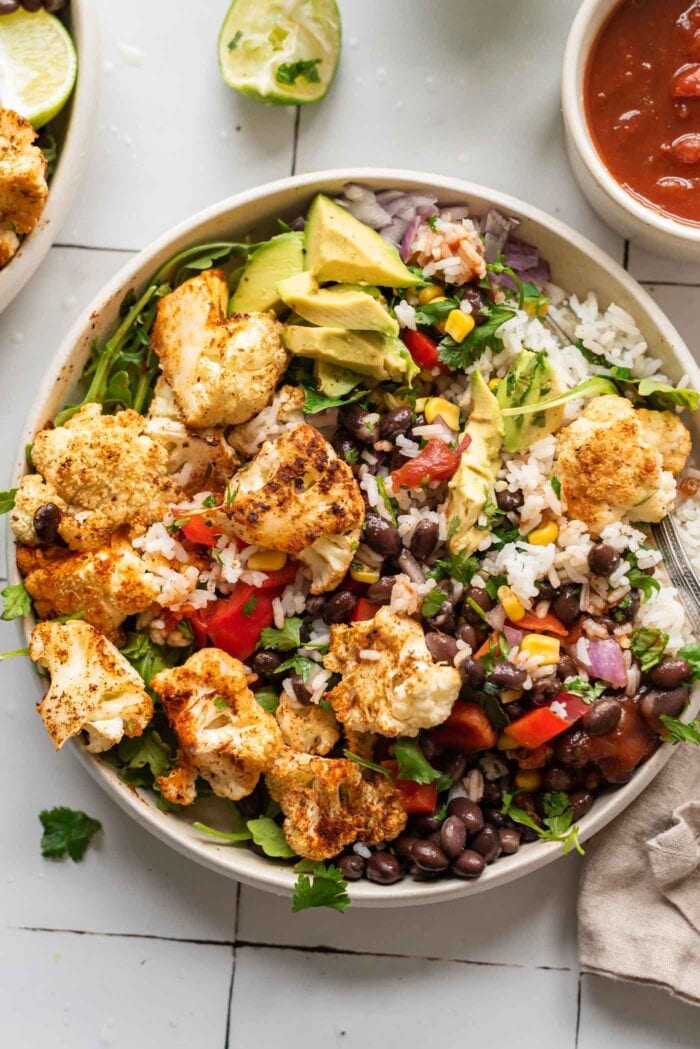
How to Build a Vegan Grocery List
Whether you’re on a budget, a vegan beginner or an experienced plant-based eater, this list will be helpful in helping you navigate any grocery store.
This list covers all the foods you might purchase if eating vegan but will vary week-to-week based on your meal plan, so it is much longer than your weekly grocery list will be.
To put together your weekly grocery list, I’d suggest sitting down on a Sunday and making a meal plan for the week.
Review my one-week vegan meal plan and 3-day whole food plant-based meal plan for ideas.
As you go, write down everything you’ll need to make the dishes on your meal plan. Depending on your dietary preferences, each week your grocery list might consist of:
- a lot of fresh vegetables
- some fresh fruit
- some frozen fruit and vegetables
- some soy such as tofu, tempeh and edamame
- any pantry items you’re out of such as dried and canned legumes, spices and dried herbs, nuts, seeds, vinegar, nut butter etc.
- dairy-alternatives such as almond or cashew milk and dairy-free yogurt
- whole grains such as oats, rice and quinoa and whole grain products such as popcorn, bread, pasta
- limited lightly processed foods such as cereal or healthy crackers
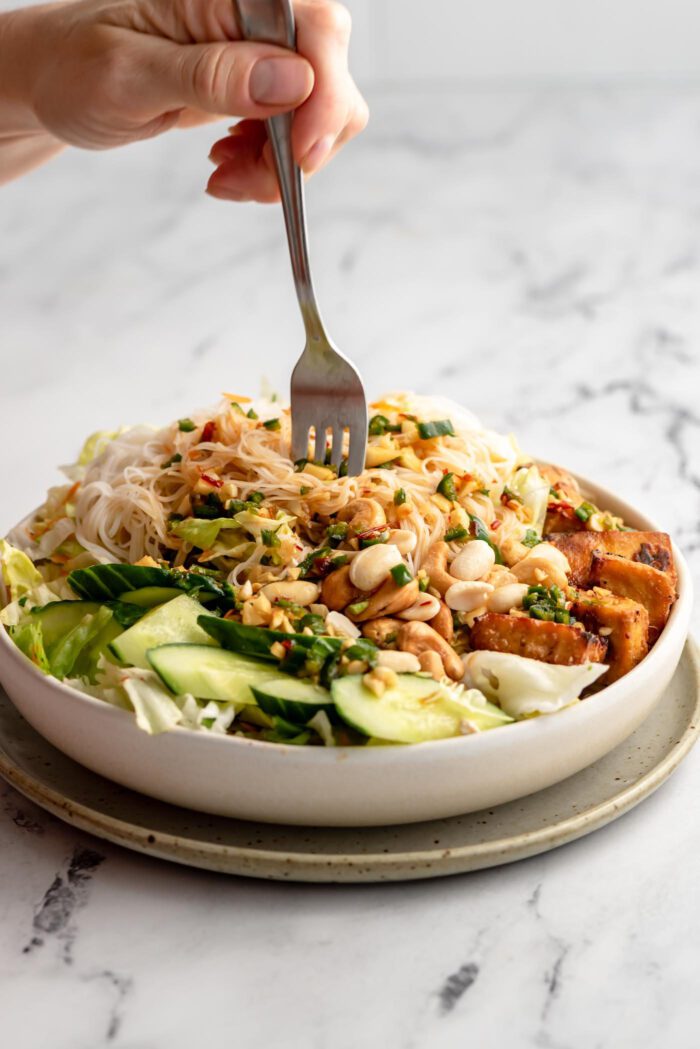
Shopping For Nutrients
When planning for your of plant-based eating, it can help to think about filling your cart with:
- nutrient-dense foods such as leafy greens and colorful fruits and vegetables
- high-fiber foods such as whole grains, fruits and vegetables
- unrefined carbohydrates/starches such as potato, sweet potato, rice, oats and quinoa
- foods that are low in added sugar, sodium and fat (minimize processed foods)
- some sources of healthy fats such as avocado, nuts and seeds
- enough food to cover your nutrient and calorie needs
- some sources of protein such as nuts, seeds, lentils, beans, tofu, tempeh and edamame
I’d suggest reading my vegan nutrition guide and plant-based protein guide as well to help you determine what foods need to be on your weekly grocery list from a nutrition standpoint.
You may also find my guide to transitioning to a plant-based diet helpful.
What Do Vegans Not Eat?
This list is all about what does go on a vegan grocery list but I thought it would be helpful to quickly cover what does not go on a vegan grocery list.
Here are the items that are not part of vegan diet:
- butter
- cream
- eggs
- dairy cheese
- dairy milk
- meat, poultry
- fish, shellfish
- gelatin
- honey (I include raw honey in my diet but it is not vegan)
Vegan Grocery List
From week to week the specific vegetables you buy will vary but they’ll always make up the base of your shopping.
Choose some starchy veggies such as potato and sweet potato, a leafy green or two and a selection of tomatoes, bell peppers, cauliflower, broccoli, zucchini, mushrooms and onions.
As for fruit, I always buy frozen berries for adding to smoothies, oatmeal and for snacking. Bananas, apples and oranges are also staples at our house.
Before you get started, I’d suggest stock up on dried herbs and spices for flavoring your dishes without the need for excess salt. Various types of vinegar, nutritional yeast, mustard, lemons and limes are also helpful for this.
Once you’ve got your fresh fruits and vegetables, start choosing some starchy, unrefined carbohydrates such as sweet potato, potato, squashes, rice, quinoa, beans and lentils.
This grocery list covers:
- Fruit. Fresh, frozen.
- Vegetables. Fresh, frozen, canned.
- Legumes. Canned, dried, fresh soy products.
- Herbs and Spices. Fresh and dried.
- Pantry Items. Natural sweeteners, condiments, baking items.
- Dairy Alternatives.
- Whole grains and whole grain products.
- Packaged Items.
Fruits
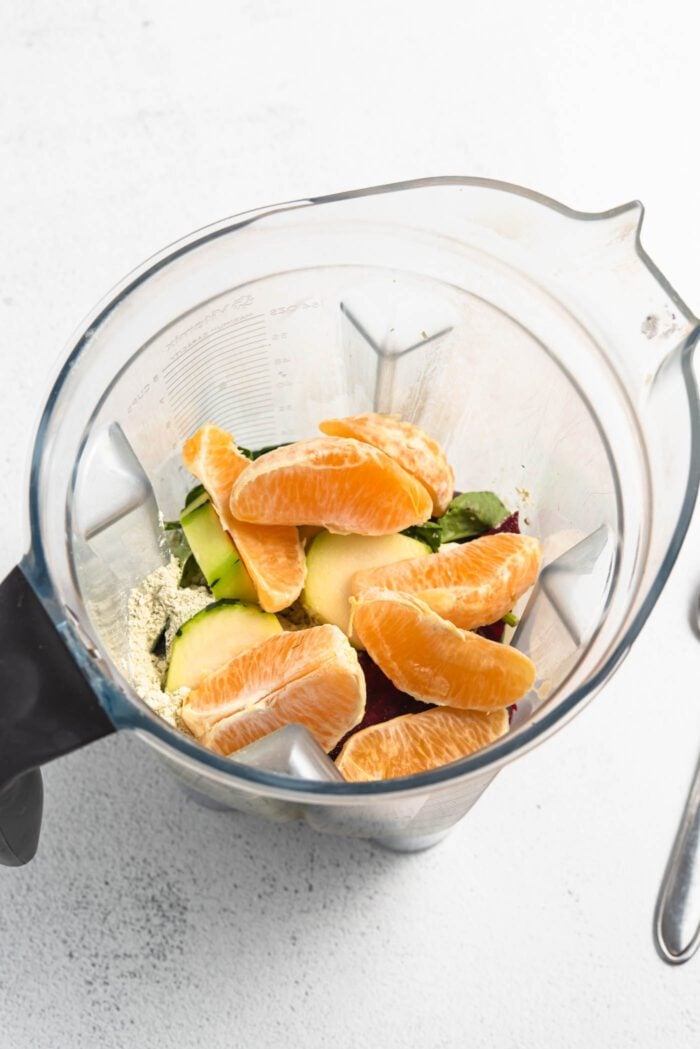
Fruits are an excellent, nutritious plant-based food to enjoy on a daily basis. Fruit is rich in fiber, antioxidants and natural energy and makes a wonderful snack, dessert and breakfast food. I like to purchase fruits like apples, bananas and berries weekly and then rotate in more exotic fruits like persimmon, kiwi, mango and papaya.
I try to vary my intake of fruits as much as I can so I vary the micronutrients I get each week. All fruits are packed with vitamins, minerals, phytonutrients and antioxidants you need to feel your best.
You can include fresh, dried and frozen fruits in your diet but I’d recommend focusing on fresh and frozen. There’s nothing wrong with frozen fruits, in fact, they can even be more nutrient-rich than fresh counterparts since they’re picked at their peak of freshness.
I eat most of my fruit in smoothies and oatmeal and for snacking. If you include any fruit at all, go for berries. Berries are some of the most potent as far as their disease-fighting benefits.
Fresh Fruit
- Banana
- Apple
- Kiwi
- Dates
- Watermelon
- Pomegranate
- Figs
- Berries: blueberries, strawberries, raspberries.
- Stone fruits: nectarines, plums, peaches, cherries.
- Citrus fruits: lemons, limes, oranges, grapefruits, clementines, apricot.
- Melons: cantaloupe, honeydew.
- Tropical fruits: papaya, mango, dragonfruit, lychee, pineapple, passionfruit, durian, guava, jackfruit.
Frozen Fruit
Frozen fruit is great for oatmeal, smoothies, making chia seed jam and adding to baking. I most often buy frozen blueberries, strawberries, peaches, mango, cherries and pineapple and I like to freeze a number of bananas every week for smoothies. In addition to the fruits listed below, you can also wash and freeze any fresh fruit. This is handy if you find something on sale and want to stock up. Also, frozen grapes make an amazing snack.
- Berries: blueberries, raspberries, strawberries, mixed berry blends.
- Cherries
- Mango
- Mixed Fruits
- Pineapple
- Peach
Dried Fruit
I don’t eat dried fruit very often but they can be helpful from time-to-time say for a hiking snack or for someone that needs a calorie-dense source of energy. The only things I really stock on a regular basis are raisins and dates. I buy cranberries sometimes if I need them for a recipe. Goji berries are wonderful if you can find them on sale and mulberries are great too. I love them both on smoothie bowls but I don’t always have them in my kitchen.
- Cherries
- Apricots
- Figs
- Mango
- Raisins
- Cranberries
- Dates
- Mulberries
- Goji Berries
- Apple
Vegetables
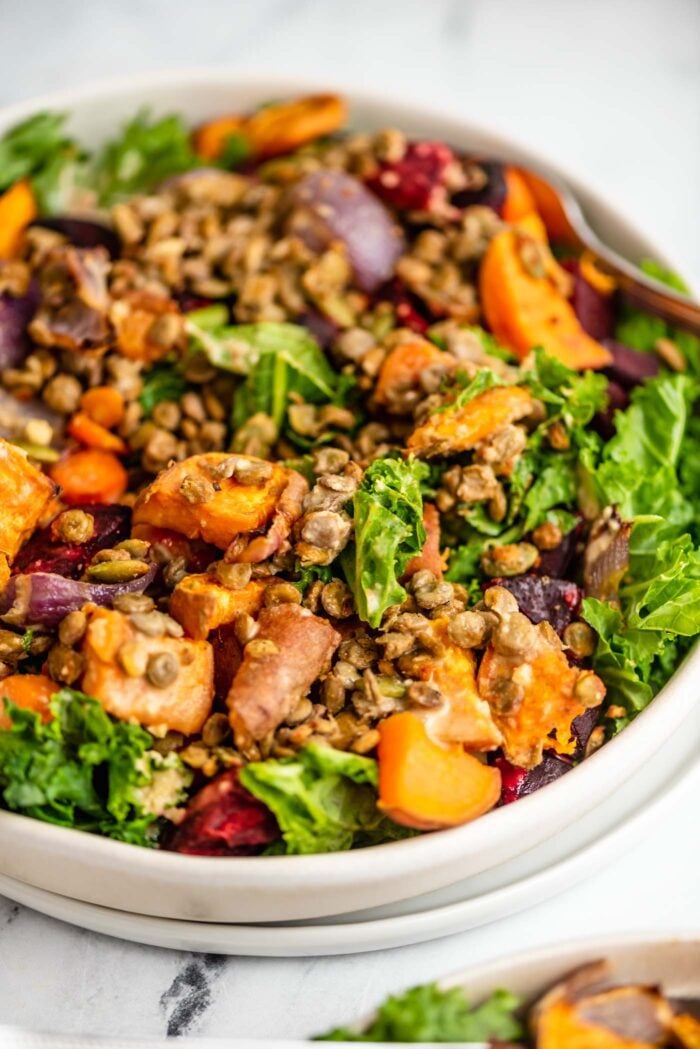
Fresh vegetables are going to make up the bulk of your diet. Vegetables are an essential food group needed to cover all your micronutrient needs.
They’re rich in fiber, enzymes, antioxidants, vitamins, minerals and phytonutrients. We need all of these things for a properly functioning body and to prevent chronic disease and nutrient deficiencies.
My vegetable shopping list varies based on my weekly meal plan, however, staples like onions, beets, broccoli, carrots, zucchini, sweet potato, spinach and kale are always on my list.
If you struggle getting greens into your diet, check out my vegan smoothies e-book for all the ways you can sneak vegetables into delicious smoothies without even knowing it.
This is particularly useful if you find yourself wasting food each week. Veggies you’re not going to get to can be frozen for adding to healthy smoothies to prevent food waste and increase your nutrient intake.
Fresh Vegetables
- Leafy green. Kale, spinach, arugula, collard greens.
- Cruciferous veggies: cauliflower, broccoli, red cabbage, green cabbage, napa cabbage, brussel sprouts.
- Root vegetables: parsnips, carrots, sweet potato, yams, white sweet potato, potatoes, turnips, rutabagas.
- Zucchini.
- Cucumber (actually a fruit but I’ll list it here!)
- Asparagus
- Beets
- Bell peppers
- Carrots
- Artichokes
- Tomatoes of all varieties.
- Hot peppers of all varieties.
- Celery
- Avocado
- Onions and shallots
- Mushrooms of all varieties.
- Garlic
- Eggplant
- Ginger
- Sweet potatoes and yams
- Potatoes
- Squash: butternut, acorn, kabocha, pumpkin, hubbard.
- Zucchini
- Green beans, green peas, snap peas, snow peas (actually legumes but we’ll inlcude them here in veggies)
Jar and Canned Vegetables
I don’t really buy any canned vegetables except for diced tomatoes and pumpkin but some to consider are:
- Corn
- Peas
- Tomato paste
- Diced tomatoes
- Whole tomatoes
- Pumpkin
- Artichokes
- Sun-dried tomatoes
Recipes to try: Red Lentil Tomato Soup // Roasted Red Pepper Tomato Soup // Vegan Chickpea Quinoa Stew
Frozen Vegetables
I don’t really stock frozen veggies aside from peas and corn but that doesn’t mean there’s anything wrong with them. I think it depends on your time restrictions for cooking and how much food you go through per week. If you’re on your own or don’t each much, frozen veggies can help prevent food waste. If you’re pressed for time, having pre-washed and chopped frozen vegetables on hand can be a lifesaver. There’s no need to shy away from frozen veggies if that’s what works for you.
Some common frozen vegetables you may want to include on your grocery list are:
- Corn
- Green peas
- Mixed stirfry veggies
- Brussel sprouts
- Butternut squash
- Green beans
Recipes to try: Vegan Cauliflower Fried Rice // Pineapple Cashew Cauliflower Rice // Vegan Sweet Potato Corn Chowder
Legumes
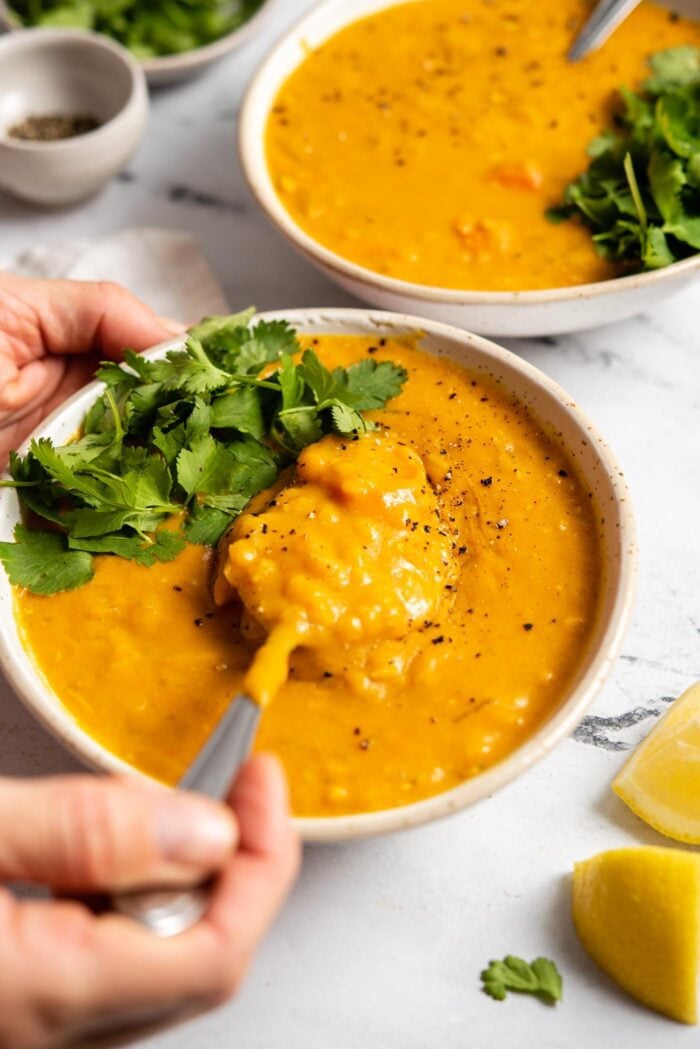
Legumes include beans, lentils, soy and peanuts and it might be my favorite grocery category. It’s a big one and they make up a big part of my diet. Legumes are a great source of protein in a plant-based diet and they provide many essential vitamins, minerals and antioxidants.
Legumes are also rich in fiber and have studies have shown many promising health benefits to include in your diet on daily basis.
I use canned beans most often but also cook dried beans sometimes as well. Canned beans and lentils are a wonderful item to stock in your pantry for quick and healthy meals. That being said, don’t be intimidated by cooking dried beans.
Using dried beans in your kitchen is very budget-friendly and if you plan ahead, it’s easy to include homecooked beans in your weekly meal plan. I always cook my own lentils because they cook quickly and don’t require soaking.
Dried Legumes
- Black eyed beans
- White kidney beans
- Fava peans
- Pinto beans
- Kidney beans
- Green lentils
- Red lentils
- French lentils
- Split peas, yellow and green
- Adzuki beans
- Navy beans
Recipes to try: Roasted Vegetable Lentil Salad // Slow Cooker Vegan Red Lentil Chili // Coconut Red Lentil Dahl
Canned Legumes
- Black beans
- Kidney beans
- White kidney beans
- Pinto beans
- Black eyed peas
- Lentils
Recipes to try: Easy Vegan Minestrone Soup // Spicy Chickpea Wraps // Spicy Vegan Black Bean Soup
Soy Products
Soy products are an excellent source of protein and other nutrients in a vegan diet. Read my guide to tofu and tempeh for more information on their health benefits.
- Tofu of all varieties
- Tempeh
- Edamame
- Soy protein
- Soy milk
Recipes to try: Tempeh Quinoa Macro Bowl // Vegan Herbed Tofu Ricotta // Vegan Buddha Bowl with Tofu and Edamame
Peanut Products
- Peanut butter
- Peanuts
Nuts and Seeds
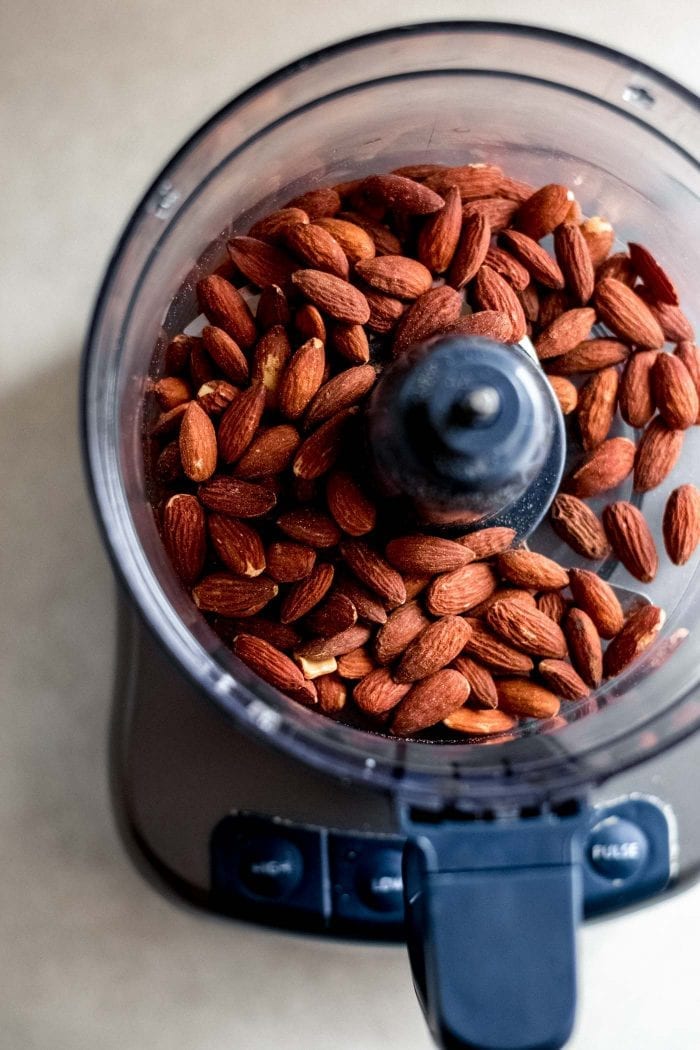
Nuts and seeds is a wonderful category full of healthy, nourishing foods that act as a source of dietary fat and protein. Nuts and seeds are rich in nutrients like vitamin E, iron, calcium, omega-3 fatty acids, zinc, magnesium and more. I stock raw almonds, walnuts, cashews, hemp seeds, pumpkin seeds, sesame seeds and sunflower seeds in my kitchen on a regular basis. I use other nuts on an as needed basis.
Nuts are great for snacking, can be added to smoothies, oatmeal and baking and can be used to make your own plant milk, energy bars and energy balls.
If you’re on a budget, seeds are a great way to enjoy the nutritional benefits of nuts without the higher price tag. You can also watch for sales, stock up and freeze to keep nuts fresh.
- Nuts: pecans, walnuts, cashews, brazil nuts, pistachios, hazelnuts, pine nuts
- Seeds: sunflower seeds, hemp seeds, chia seeds, flaxseeds, pumpkin seeds (pepitas), sesame seeds
- Nut butter: almond butter, cashew butter, peanut butter
- Seed butter: tahini, sunflower seed butter
Whole Grains and Whole Grain Products
Whole grains are a staple in a whole food plant-based kitchen. I always stock quinoa, brown rice, rolled oats and farro, the rest I buy on an as needed basis.
We buy bread weekly as well and like Silver Hills, Ezekiel and Dave’s Killer Bread as well as fresh bread like sourdough and rye from local bakeries.
As for flours, I stock quinoa flour and chickpea flour for pancakes and use whole-wheat or gluten-free flour for occasional baking.
- rolled oats, steel-cut oats
- brown rice, wild rice and other rice varieties
- quinoa
- farro
- freekeh
- millet
- amaranth
- teff
- buckwheat
- barley
- Bakery: breads, buns, tortillas
- Pasta: brown rice pasta, quinoa pasta, whole wheat pasta
- Rice cakes
- Whole grain flours: quinoa flour, buckwheat flour, whole wheat flour
Dairy Alternatives
I buy dairy-free coconut yogurt often and enjoy it topped with berries and granola, mixed with protein or on top of oats. I also buy almond and cashew milk often as well as make my own oat milk, hemp seed milk and almond milk. Depending on the brand, some of these are healthier than others but regardless they can be very helpful as you’re transitioning towards a more plant-based diet. Read my post on vegan options to replace dairy for more information.
- coconut yogurt
- almond or cashew yogurt
- cashew cheese
- dairy-free milk such as almond, oat, soy, rice, hemp, cashew or coconut
Processed Dairy Alternatives
We’ll talk more about processed foods later in the post but if you’re just starting out and need some dairy alternatives to help you transition, you can consider items such as:
- vegan sour cream
- vegan cream cheese
- cheddar or mozzarella style shreds
- cheese slices
- chocolate soy or almond milk
- coconut creamer
- Earth Balance butter
- vegan ice cream
Brands that make products in this category include Daiya, Earth Balance, Follow Your Heart, So Delicious, GO Veggie, Silk, Yoso, Almond Breeze and Tofutti.
I’m not a big cheese person so I don’t really buy much in this area. I’ll buy So Delicious ice cream once in a blue moon and I’ve bought and enjoyed Follow Your Heart cheese before. I’m not a huge fan of Daiya cheeses but they’re okay and do melt well for pizza and sandwiches etc. I do buy Silk almond and cashew milk weekly though.
I’m very lucky to live in Vancouver where have a number of local brands doing amazing things with whole food nut-based cheeses and you can find everything from vegan brie to harvarti, parmesan to cream cheese.
Herbs and Spices
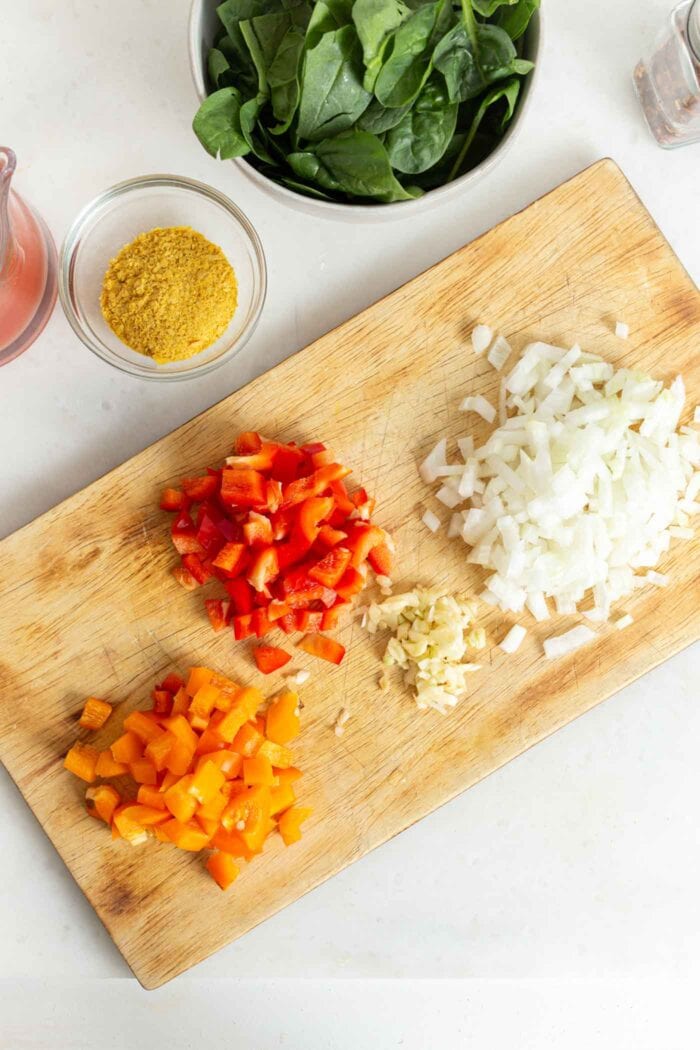
Having a well-stocked pantry of dried herbs and spices will help you create flavorful meals without the need for excess salt. That being said, since you’ll be eating low-sodium, whole foods (as opposed to processed foods that contain excess sodium), there’s nothing wrong with using a good quality sea salt in your kitchen to flavor your food. Sea salt is rich in trace minerals and can be a healthy addition to your diet.
Both dried and fresh herbs and spices are rich in antioxidants and have many beneficial and anti-inflammatory properties. My favourites are garlic, ginger, turmeric, cilantro, basil, dill, cumin, cinnamon and coriander.
Adding herbs & spices to your food not only kicks up the flavor but is also quite beneficial to your health. Many of these seasonings come with enormous antioxidant and anti-inflammatory capabilities.
- dried basil, fresh as needed
- dried bay leaves
- celery seed
- ground chili powder
- red pepper flakes
- cayenne pepper
- fresh chives
- fresh or dried cilantro (coriander)
- cloves
- cumin
- curry powder
- turmeric
- fresh garlic, garlic powder
- fresh gingerroot, ground ginger
- Italian seasoning
- ground thyme
- onion powder
- dried oregano
- dried rosemary, fresh as needed
- dried dill, fresh as needed
- dried parsley, fresh as needed
- black peppercorns
- sea salt
Miscellaneous and Pantry Items
I have a thorough post on how to stock a vegan pantry but we’ll cover pantry basics in this section.
Natural Sweeteners
Whether you use sweeteners in your kitchen is up to you. I use dates, banana, applesauce, coconut sugar, maple syrup and stevia in my kitchen. If you like baking, you can use any of the sweeteners below for an unrefined option to refined white sugar.
- agave syrup
- coconut sugar
- maple syrup
- molasses
- stevia
- organic cane sugar
- dates
Condiments
These items are helpful for taking the flavor of all those veggies up a notch. I stock all of these and use them often to create sauces, dressings and curries and flavor all kinds of dishes.
- coconut milk
- red curry paste
- green curry paste
- soy sauce or gluten-free tamari
- miso paste
- mustard
- salsa
- organic ketchup
- sweet chili sauce
- nutritional yeast (read more here)
- saerkraut
- vinegar: red wine, balsamic, apple cider, rice wine
Baking and Cooking Items
- baking powder
- baking soda
- cornstarch or arrowroot powder
- pure vanilla extract
- any other extracts you like such as peppermint or almond
- shredded coconut
- coconut flakes
- vital wheat gluten (used to make seitan)
- various flours such as chickpea flour, quinoa flour, coconut flour, almond flour
Packaged Favorites and Treats
Up until this point, we’ve covered all the whole plant foods you’ll need to enjoy a vegan diet and feel good while doing it. Now, you may want to eat 100% whole food plant-based, 100% of the time and that’s awesome! However, there’s also nothing wrong with including some processed foods in your diet every so often.
Transition Foods
Changing your eating habits is a big undertaking and these types of food may be particularly helpful as you transition to a plant-based lifestyle. Sustainability is important too so try not to put things into “good” and “bad” categories.
Sure, sometimes food will just be fuel but sometimes it can be a source of comfort too. Vegan meat and dairy alternatives may be especially helpful as you transition away from an animal-product heavy diet. There are plenty of decent alternatives to dairy available today.
Creating Sustainability
For myself, you better believe I eat chocolate, chips, cookies, vegan ice cream, go out for vegan pizza. Day to day, I eat whole food plant-based and I love how it makes me feel but I also love enjoying treats. By eating well 90% of the time I can go ahead and enjoy some goodies too, no worries. I also believe the stress of worrying or feeling guilty about eating a vegan chocolate chip cookie is worse than just eating the darn cookie.
Luckily, processed vegan foods have exploded on the market and while there is definitely still some crap out there, there are a ton of wonderful brands making yummy treats we can all enjoy.
- Field Roast Sausages
- Yves products
- Kombucha
- Gardein products
- Simply Protein Bars, Go Macro Bars
- Frozen Veggie Burgers
- Canned soups such as Amy’s
- Dark Chocolate
- So Delicious Dairy-Free Ice Cream and other vegan frozen treats
- Vegan Jerky
- Frozen waffles from Nature’s Path or Ezekiel
- Larabars (or make your own!)
- Beanfield’s Chips
- Veggie Sticks
- Mary’s Organic Crackers
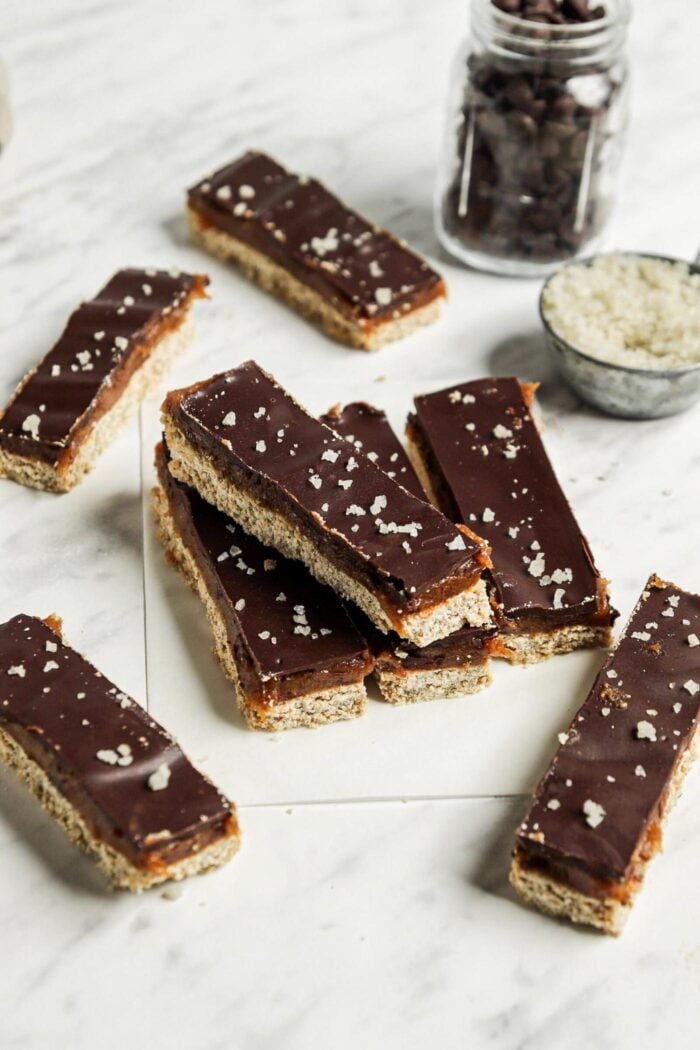
How much does a plant-based diet cost?
I have a quick answer for this: much less than buying eggs, cheese, meat, milk, fish and other animal products.
It’s a common misconception that a vegan diet is expensive. It certainly can be expensive if you buy a lot of packaged vegan foods but if you stick to whole foods, it’s a very inexpensive way to eat.
Rice, beans, lentils, fresh fruits and vegetables are all very inexpensive and if you’ve got the basics you’ll have more than enough to create delicious plant-based meals.
From there, if your budget allows, you can spend more on luxury items like superfoods, more nuts, seeds and nut butter and more of the many wonderful vegan products that have exploded onto the market.
For budget tips, check out my extensive post about healthy eating on a budget.
Where to Buy Vegan Food?
You can buy most of the foods you’ll need at any grocery store. This includes fruit, vegetables, rice, beans, nuts, seeds, soy products and whole grains. For specialty items, the best stores to buy vegan foods are:
- Whole Foods
- Trader Joe’s
- Costco
- Aldi
- Target
- Health food stores
- Asian grocery stores
- Farmer’s markets
- Online through Amazon or Thrive Market
Local to me, we have Whole Foods, Urban Fair and Choice’s Market which are all excellent and we also have Vegan Supply Co. which has anything and everything you can imagine, so it’s worth a quick Google search of your local area to see what’s available.
Major chains should carry everything you need and every day plant-based options becoming more and more mainstream.
As demand increases, so does availability. Next time you visit your local major grocery store, dig a little deeper and you’ll be surprised at all the fun plant foods you’ll be able to find.
When in doubt, keep it simple by sticking to whole plant foods. I’m able to buy almost everything from one mainstream grocery store and only sometimes need one or two items from a more natural food-focused store, if anything at all.

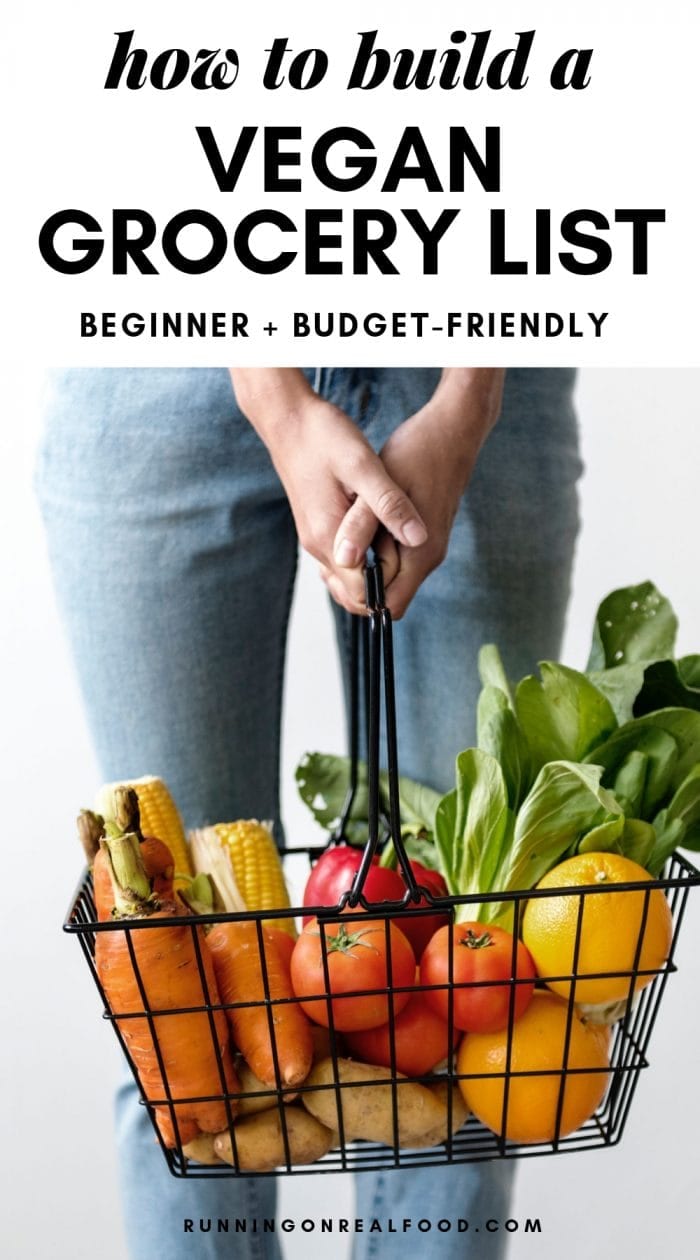

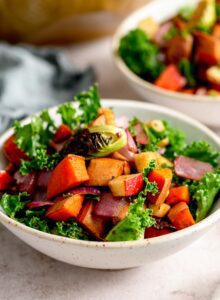
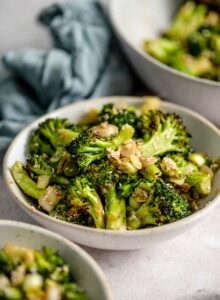
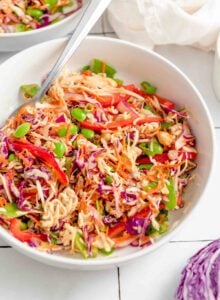
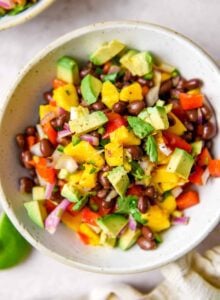
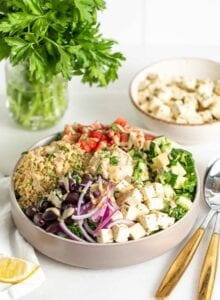
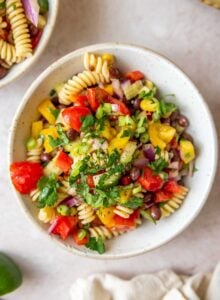
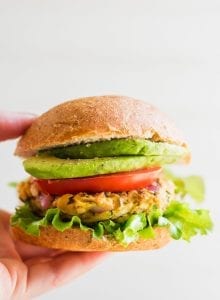
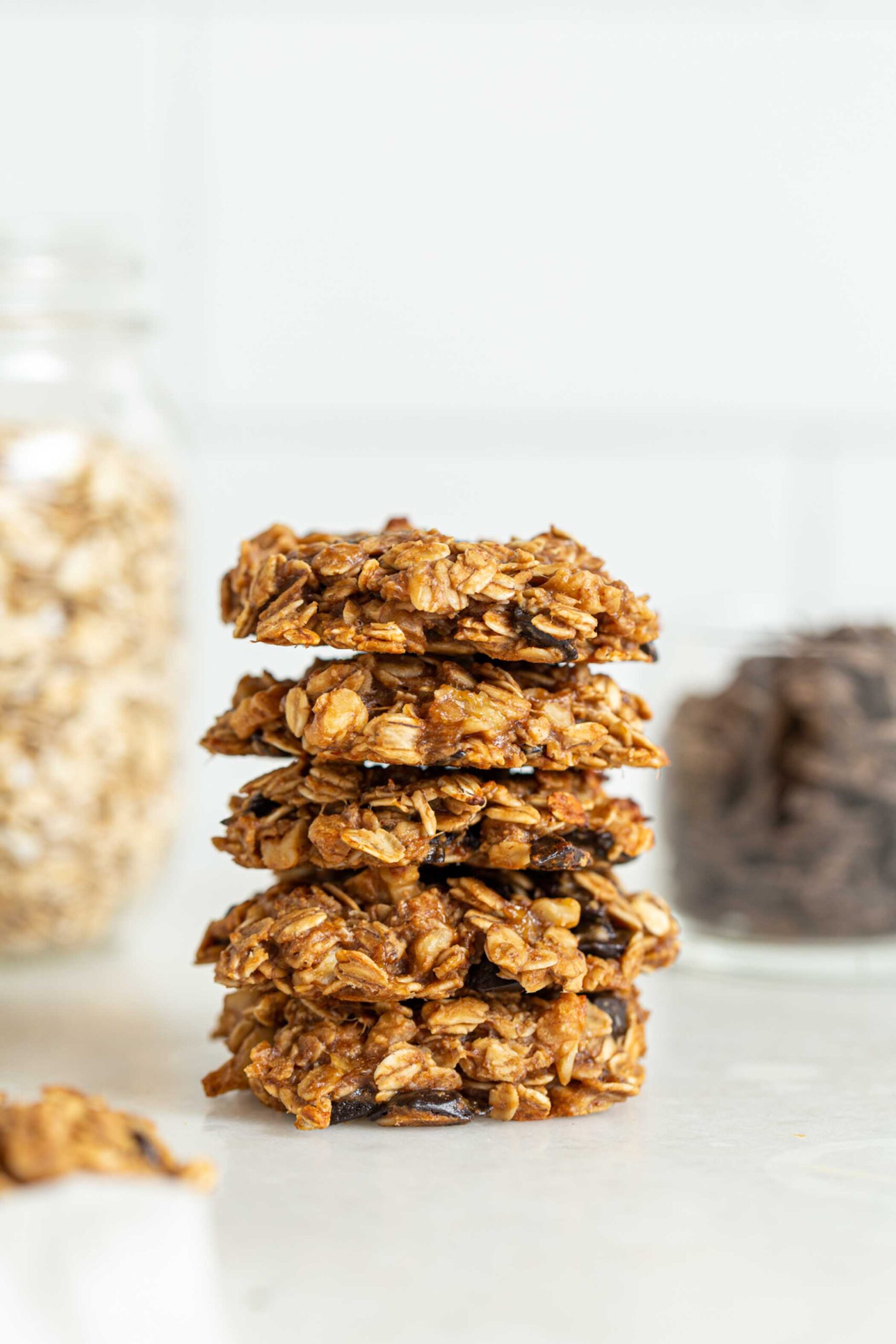
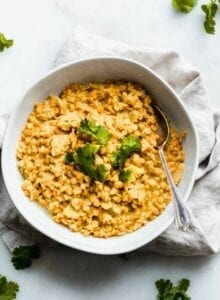
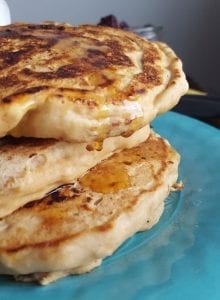
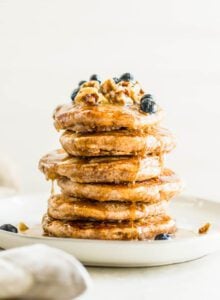

This is the best list I have seen for a newbie like myself who dived into the world of vegan. You have presented the material in such a great fashion. Do you by chance have any exposure to kosher items as I am an orthodox Jew with a kosher dietary restrictions? Thank you again.
Hi Susan, I’m sorry I don’t have much exposure to kosher items. Best of luck!
I love the guide to buiding my grocery list. I’ve learn a lot from your artice what I need to build my grocery list . Thank you so much for your guidance.